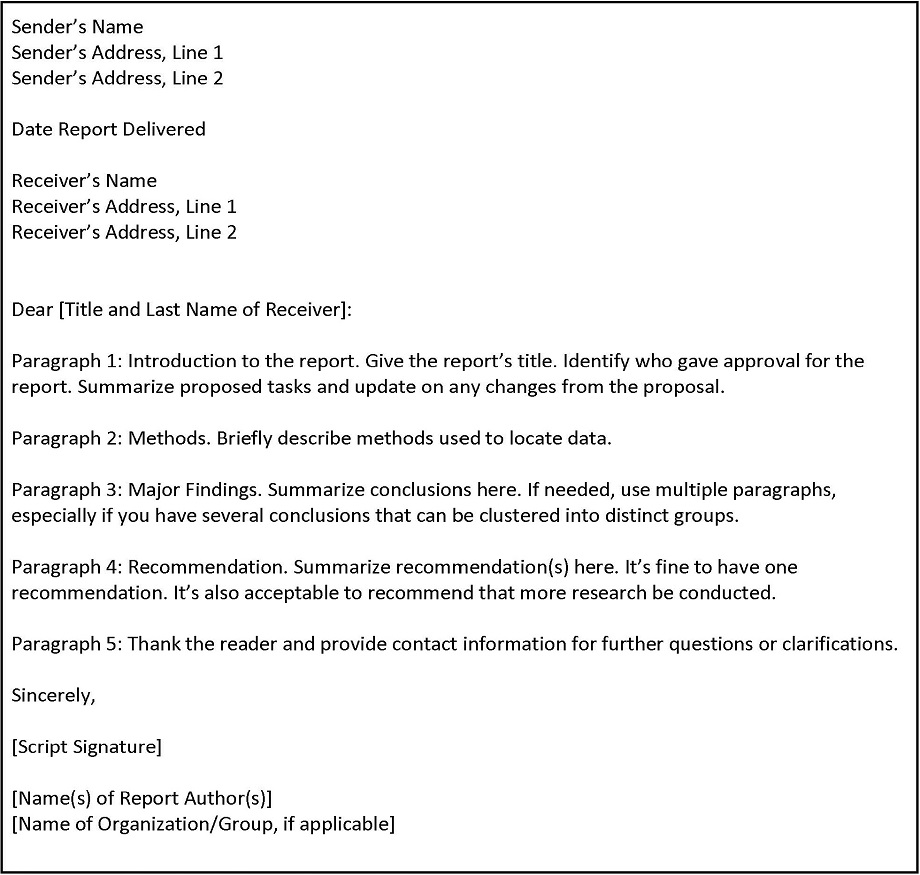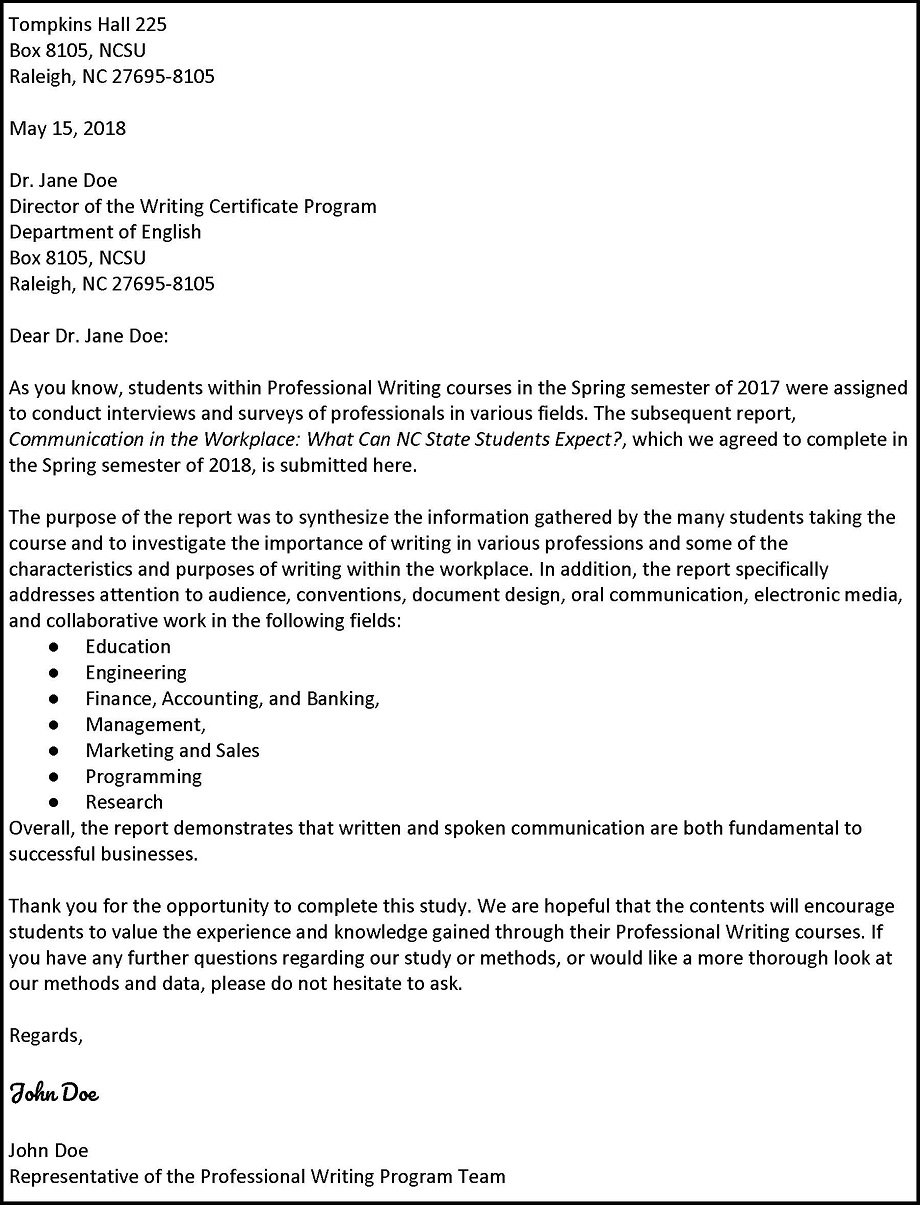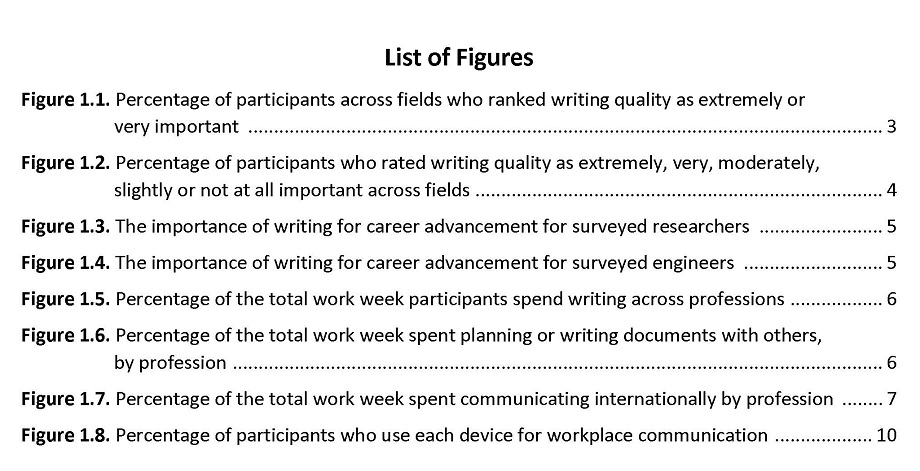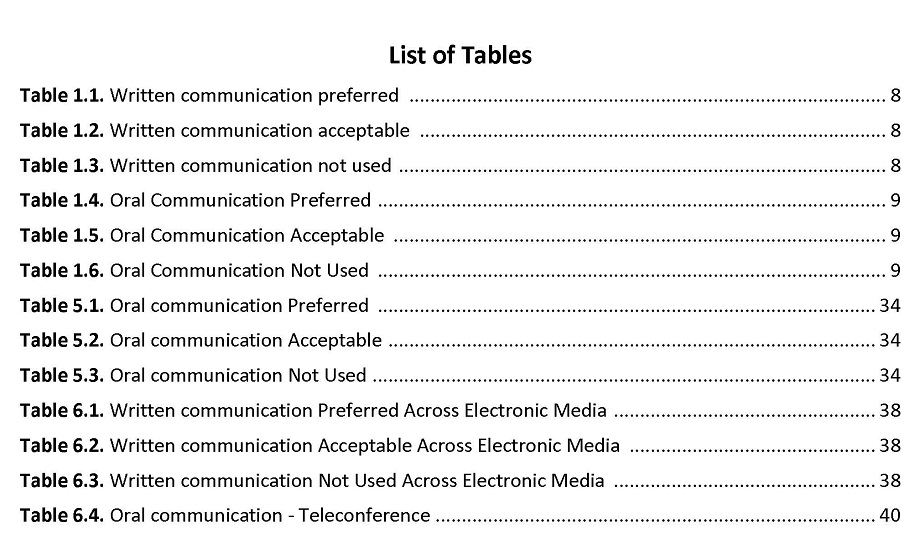20 – Recommendation Reports
Front Matter
David McMurrey; Annemarie Hamlin; Chris Rubio; Michele DeSilva; Nicole Hagstrom-Schmidt; Matt McKinney; and Kalani Pattison
The front matter of a report refers to portions that summarize and inform the reader of the contents of the report. These documents all appear prior to the report itself. Common components of front matter include a letter of transmittal, a title page, some form of summary, a table of contents, and lists of figures and/or tables. While they come first in order, these components are usually composed last as it is difficult to summarize what is not written, and even harder to assign page numbers for it.
Letter of Transmittal
The letter of transmittal is a cover letter that is attached to the outside of the report. Traditionally, printed reports would have the letter of transmittal attached with a paperclip or bound within the report. Thus, this letter is not considered when assigning page numbers to the report.
A transmittal letter is a communication from you (the report writer) to the recipient (the person who requested the report and who may even be paying you for your expert consultation). Essentially, this letter says, “Here is the report that we agreed that I would complete by a certain date. Briefly, it contains this and that, but does not cover this or that. Let me know if it meets your needs.” The letter of transmittal also explains the context or the events that brought the report about.
In the template of the letter of transmittal that follows in Figure 20.1,[1] notice the standard business-letter format. If you write an internal report, use the memorandum format instead. In either case, the contents and organization are the same:
First paragraph. Provides the name of the report, putting it in italics. It also mentions the date of the agreement to write the report.
Middle paragraphs. Focus on the purpose of the report and give a brief overview of the report’s contents.
Final paragraph. Encourages the reader to get in touch if there are questions, comments, or concerns. It closes with a gesture of goodwill, expressing hope that the reader finds the report satisfactory.
As with any other element in a report, you may have to modify the contents of this letter (or memo) for specific situations. For example, you might want to add another paragraph listing questions you’d like readers to consider as they review the report. Figure 20.2[2] shows what this might look like.


Title Page
The next item in a report is the title page. Remember, without a title page, a report is anonymous; it gets ignored.
There are no standard requirements for the title page, although your company or organization should have its own requirements. However, most reports include the following:
- The report title
- The author’s/authors’ name(s)
- The name of the author’s organization
- Date of delivery.
An example of a report cover is shown below in Figure 20.3.[3]

Types of Summaries
In most technical reports, you will encounter one of three types of summary in the front matter: executive summaries, abstracts, or the generic pure summary. These types all have one important similarity: they are distillations of a larger document’s key components. However, each of them serves a distinct purpose based on the needs of their audiences and the rhetorical contexts in which they are situated. Understanding these purposes and the rhetorical situations that shape executive summaries, abstracts, and pure summaries will help you craft each of them more effectively.
Executive Summaries
An executive summary summarizes the key facts and conclusions contained in the report. Think of this section as if you used a highlighter to mark the key sentences in the report, then siphoned them onto a separate page, and edited them for readability. Typically, executive summaries are one-tenth to one-twentieth the length of reports ten to fifty pages long. For longer reports, ones over fifty pages, the executive summary should not go over two pages. The point of the executive summary is to provide a summary of the report—something that can be read quickly.
Executive summaries are typically found in business reports. While they do provide some description of the subject and how it was investigated for the sake of context, executive summaries emphasize results and recommendations above all else. Unlike abstracts and pure summaries, they are designed to be read by audiences who will not read the full report but who still have an interest in the report’s findings and any recommendations for taking a specific action.
Example Context
You write a recommendation report for your organization that offers a strategy for shifting to more diverse hiring practices. Your immediate supervisor will read the report in full, but the board of directors will need the executive summary to make a quick decision on whether to adopt your strategy.
Abstracts
Abstracts are typically found in scientific and academic articles. Rather than standing in for the full document, like an executive summary would, the abstract’s primary function is to convince the audience to read the full document. Additionally, its content tends to mirror the IMRaD structure (Introduction, Methods, Results, and Discussion), instead of focusing primarily on results or actionable items. Most electronic databases show an article’s abstract in the search results, so researchers will likely be perusing multiple abstracts when deciding what to include in their own papers. As a result, you need to make sure that your abstract stands out and fulfills your audience’s needs.
Example Context
You write a peer-reviewed article for a medical journal on clinical trials you conducted for a cancer drug. Now that the article is published, you want other scientists to replicate and/or respond to your study (and better yet, cite it in their own publications). To help ensure this happens, you emphasize your study’s focus and its operational definitions of key terms, outline your forms of data collection, report the data you collected, and then offer a brief interpretation.
Pure Summaries
Pure summaries are the most nebulous of the three types in terms of audience and context. This type of summary is often used simply to introduce a larger document or speech and to provide some initial signposting to help the audience navigate it. (For an in-depth discussion of signposting, see Chapter 6). Since executive summaries and abstracts are typically found in more specific rhetorical situations, the best way to distinguish a pure summary from these is to check it against the characteristics of each. In other words, is the summary meant to be read instead of the full report? Is the summary meant to convince the reader to keep reading, or is it meant to help them navigate content as they read further? If the last question seems like the best fit, a pure summary is very likely the best choice.
Example Context 1
The Writer’s Memos you will write for the major assignments in this class feature a pure summary section. Your instructor will read the full memo, but will expect an overview of each subsequent section.
Example Context 2
When you are giving an oral presentation, it is traditionally good practice to open with a pure summary of your talk. Since the audience cannot go back and review your ideas as they could with a document, outlining your structure up front and then repeating it helps them anticipate and retain your points (see Chapter 14: Oral Communication).
Note
Summary Tip: If the executive summary, introduction, and transmittal letter strike you as repetitive, remember that readers do not always start at the beginning of a report and read page by page to the end. They skip around. For example, they may scan the table of contents; skim the executive summary for key facts and conclusions; or read carefully only a section or two from the body of the report, and then skip the rest. For these reasons, reports are designed with some duplication so that readers will be sure to see the important information no matter where they dip into the report.
Case Study: Applying All Three Summary Types to One Report
To understand the differences between executive summaries, abstracts, and pure summaries, let’s look at how each could be drafted for the same project: improving a student organization’s recruitment strategy so that they attract a more diverse membership. Keep in mind that these are just examples and that some research projects are more complex than others. Also note that these examples are split into smaller paragraphs to enhance readability.
Executive Summary. Over the last three years on campus, the Texas A&M chapter of Future Coders of America (FCA) has struggled with increasing diversity in its membership. This lack of diversity has become noticeable in comparison to that of other student organizations and the demographics of the university as a whole. Using triangulated forms of data collection, including interviews with faculty and researching other university organizations, our team conducted research on this issue in order to improve diversity in the FCA over the next three years.
Results show that to attract a diverse membership, a student organization must establish close ties with campus diversity centers and resources, form partnerships with other student organizations, and encourage diversity within its own leadership. We therefore recommend that the FCA reach out to the campus diversity center and promote future events there, reach out to the Society of Women Coders and collaborate on hosting an event, and focus on leadership diversity long-term, when these initial strategies result in a more diverse membership.
Abstract. This study investigates the issue of diversity in the recruitment strategies of Texas A&M Future Coders of America (FCA). Over the past three years, the FCA’s focus on recruitment has resulted in a membership that is disproportionately white and male in comparison to other student organizations and the demographics of Texas A&M as a whole.
For the purposes of this study, we define diversity in terms of race and gender. Using this definition, we collected data through a variety of methods. These methods include surveying students who are active in organizations with more diverse membership, interviewing the faculty advisors for the university’s Diversity Office, interviewing the leaders of student organizations with more success recruiting diverse members, and researching FCA chapters at other universities.
Through these methods, we discovered that partnerships with campus diversity offices and other organizations are the best strategies for improving diversity in recruitment. A recurring pattern among surveyed students reveals that diverse leadership is also important. We discuss how these findings can be applied by the FCA in subsequent years.
Pure Summary (for a verbal presentation). Today we are going to discuss the issue of diversity in recruitment for the TAMU chapter of the Future Coders of America (FCA). We will begin with a review of the status quo, illustrating how the FCA is behind other student organizations at Texas A&M. From there, we will clarify our decision to define diversity in terms of race and gender, and how that led to our methods.
We will then discuss the process we undertook in interviewing organization leaders and the Diversity Office faculty advisors, surveying active organization members, and researching FCA chapters on other campuses. With each method of data collection, we will discuss trends in the data and how we shifted our expectations. Finally, we will conclude by reviewing our proposed solutions, which are to form a partnership with the Diversity Office and host joint events with other student organizations.
Note the shift in focus for each summary type. The executive summary, for example, highlights the results and actions the FCA can take to resolve the issue, without going into the methods. The abstract, by contrast, highlights how the focus of the study is reflected in its definition of key terms and the methods of data collection it employs. While the pure summary also addresses these points, it does not give more weight to any section over the others, and it frames itself as a signpost for the rest of the presentation.
Table of Contents
You are likely familiar with tables of contents (TOC) but may never have stopped to look at their design. The TOC shows readers what topics are covered in the report, how those topics are discussed (the subtopics), and on which page numbers those sections and subsections start. In creating a table of contents, you have a number of design decisions:
Levels of headings to include. In longer reports, consider including only the top two levels of headings. This keeps the TOC from becoming long and unwieldy. The TOC should provide an at-a-glance way of finding information in the report quickly.
Alignment and spacing. Notice in Figure 20.4[4] below that items in each of the different levels of headings are aligned with each other. In addition, page numbers are right-aligned.
Capitalization. Main chapters or sections use all capital letters or small caps (the letters are all capitalized, but the first letter is larger); first-level headings capitalize the first letter of each main word (this is also referred to as “title case”); lower-level sections capitalize the first word only (this is also called “sentence case”).
Vertical spacing. Notice that the first-level sections have extra space above and below, which increases readability. Second-level sections, however, are single spaced.
Using the automatic TOC creator in your word processor can help you produce a clean, professional document. If you prefer to make your own, learn to use right-aligned tabs (dot leader tabs when possible) in order to line up the page numbers correctly.
One final note: Make sure the words in the TOC are the same as they are in the text. As you write and revise, you might change some of the headings—don’t forget to change the TOC accordingly.

List of Figures and Tables
If your document has more than two figures or tables, you need to create a separate list of figures and tables or a list of illustrations. The list of figures and tables follows many of the same design considerations as the table of contents. Readers use the list of figures and tables to quickly find the illustrations, diagrams, tables, and charts in your report.
Complications arise when you have both tables and figures. Strictly speaking, figures are illustrations, drawings, photographs, graphs, and charts. Tables are rows and columns of words and numbers; they are not considered figures.
For longer reports that contain dozens of figures and tables each, create separate lists of figures and tables, as shown below. If they fit, you may put them together on the same page. For documents with only a few figures and tables, you can combine the two lists under the heading “List of Figures and Tables” or “List of Illustrations” as long as you continue to identify them with the appropriate labels in the list. If there are no tables, it should be only a “List of Figures,” (Figure 20.5[5]) and if there are no figures, it should be only a “List of Tables” (Figure 20.6[6]).


This text was derived from
Gross, Allison, Annemarie Hamlin, Billy Merck, Chris Rubio, Jodi Naas, Megan Savage, and Michele DeSilva. Technical Writing. Open Oregon Educational Materials, n.d. https://openoregon.pressbooks.pub/technicalwriting/. Licensed under a Creative Commons Attribution-NonCommercial-ShareAlike 4.0 International License.
McMurrey, David. Online Technical Writing. n.d. https://www.prismnet.com/~hcexres/textbook/. Licensed under a Creative Commons Attribution 4.0 International License.
Swarts, Jason, Stacey Pigg, Jamie Larsen, Julia Helo Gonzalez, Rebecca De Haas, and Elizabeth Wagner. Communication in the Workplace: What Can NC State Students Expect? North Carolina State University Professional Writing Program, 2018. https://docs.google.com/document/d/1pMpVbDRWIN6HssQQQ4MeQ6U-oB-sGUrtRswD7feuRB0/edit#heading=h.n2a3udms5sd5. Licensed under a Creative Commons Attribution 4.0 International License.
- Nicole Hagstrom-Schmidt, “Template for Letter of Transmittal,” 2020. Licensed under a Creative Commons Attribution-NonCommercial-ShareAlike 4.0 International License. It references material found in Jason Swarts, Stacey Pigg, Jamie Larsen, Julia Helo Gonzalez, Rebecca De Haas, and Elizabeth Wagner, Communication in the Workplace: What Can NC State Students Expect? (Raleigh: North Carolina State University Professional Writing Program, 2018), https://docs.google.com/document/d/1pMpVbDRWIN6HssQQQ4MeQ6U-oB-sGUrtRswD7feuRB0/edit#heading=h.n2a3udms5sd5. Licensed under a Creative Commons Attribution 4.0 International License. ↵
- Kalani Pattison, “An Example of a Letter of Transmittal,” 2020. Licensed under a Creative Commons Attribution-NonCommercial-ShareAlike 4.0 International License. It references material found in Jason Swarts, Stacey Pigg, Jamie Larsen, Julia Helo Gonzalez, Rebecca De Haas, and Elizabeth Wagner, Communication in the Workplace: What Can NC State Students Expect? (Raleigh: North Carolina State University Professional Writing Program, 2018), https://docs.google.com/document/d/1pMpVbDRWIN6HssQQQ4MeQ6U-oB-sGUrtRswD7feuRB0/edit#heading=h.n2a3udms5sd5. Licensed under a Creative Commons Attribution 4.0 International License. ↵
- Kalani Pattison, “Example of a Report Title Page,” 2020. Licensed under a Creative Commons Attribution-NonCommercial-ShareAlike 4.0 International License. Derived from Swarts, Jason, Stacey Pigg, Jamie Larsen, Julia Helo Gonzalez, Rebecca De Haas, and Elizabeth Wagner, Communication in the Workplace: What Can NC State Students Expect? (Raleigh: North Carolina State University Professional Writing Program, 2018), https://docs.google.com/document/d/1pMpVbDRWIN6HssQQQ4MeQ6U-oB-sGUrtRswD7feuRB0/edit#heading=h.n2a3udms5sd5. Licensed under a Creative Commons Attribution 4.0 International License. ↵
- Kalani Pattison, “Example Table of Contents,” 2020. Licensed under a Creative Commons Attribution-NonCommercial-ShareAlike 4.0 International License. Derived from Jason Swarts, Stacey Pigg, Jamie Larsen, Julia Helo Gonzalez, Rebecca De Haas, and Elizabeth Wagner, Communication in the Workplace: What Can NC State Students Expect? (Raleigh: North Carolina State University Professional Writing Program, 2018), https://docs.google.com/document/d/1pMpVbDRWIN6HssQQQ4MeQ6U-oB-sGUrtRswD7feuRB0/edit#heading=h.n2a3udms5sd5. Licensed under a Creative Commons Attribution 4.0 International License. ↵
- Kalani Pattison, "Example List of Figures,” 2020. Licensed under a Creative Commons Attribution-NonCommercial-ShareAlike 4.0 International License. Derived from Jason Swarts, Stacey Pigg, Jamie Larsen, Julia Helo Gonzalez, Rebecca De Haas, and Elizabeth Wagner, Communication in the Workplace: What Can NC State Students Expect? (Raleigh: North Carolina State University Professional Writing Program, 2018), https://docs.google.com/document/d/1pMpVbDRWIN6HssQQQ4MeQ6U-oB-sGUrtRswD7feuRB0/edit#heading=h.n2a3udms5sd5. Licensed under a Creative Commons Attribution 4.0 International License. ↵
- Kalani Pattison, "Example List of Tables,” 2020. Licensed under a Creative Commons Attribution-NonCommercial-ShareAlike 4.0 International License. Derived from Jason Swarts, Stacey Pigg, Jamie Larsen, Julia Helo Gonzalez, Rebecca De Haas, and Elizabeth Wagner, Communication in the Workplace: What Can NC State Students Expect? (Raleigh: North Carolina State University Professional Writing Program, 2018), https://docs.google.com/document/d/1pMpVbDRWIN6HssQQQ4MeQ6U-oB-sGUrtRswD7feuRB0/edit#heading=h.n2a3udms5sd5. Licensed under a Creative Commons Attribution 4.0 International License. ↵
Paratextual components of a document that appear before the content of that document. These components may include title pages, tables of contents, and copyright information.
Summarizes the key facts and conclusions contained in the report. Typically found in business reports, they provide some description of the subject and how it was investigated for the sake of context, but executive summaries emphasize results and recommendations above all else. Meant to be read instead of the full report by certain audiences.
Typically found in scientific and academic articles, content tends to mirror IMRaD structure of paper. Summarizes important ideas using key terms which may be more easily found in database searches.

